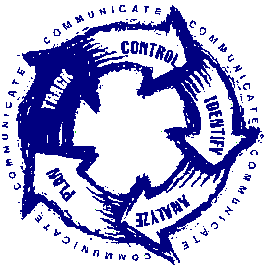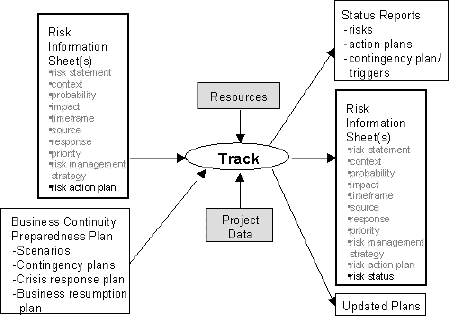Common menu bar links
Breadcrumb Trail
Institutional links
Chief Information Officer Branch
IT Project Review and Oversight
Enhanced Management Framework
ARCHIVED - A Guide to Effective Business Continuity in Support of the Year 2000 Challenge
 This page has been archived.
This page has been archived.
Archived Content
Information identified as archived on the Web is for reference, research or recordkeeping purposes. It has not been altered or updated after the date of archiving. Web pages that are archived on the Web are not subject to the Government of Canada Web Standards. As per the Communications Policy of the Government of Canada, you can request alternate formats on the "Contact Us" page.
6.0 Track
Departments must develop the capability to continuously assess risk and report on the progress of the business continuity plans and the conversion activities. Status reports emerging from this step will feed in the business continuity process and trigger the proper management actions such as activating contingency plans, declaring a crisis, or resuming a business function. Inadequate tracking may lead to ineffective actions or chaos that can disrupt operations.
6.1 Process

Note: Risk tracking is based on the SEI "Track" process
[CRMGuidebook, Chapter
7,
Page 73].
The tracking step aims at collecting progress information from the conversion activities and risk action plans and feeding issues and risks into the business continuity process. Other indicators that could activate contingencies or emergency responses should also be tracked. This will provide a disciplined environment that allows departments to:
- Continuously assess what could go wrong;
- Determine which risks are important to deal with and could negatively impact the continuity of the department's business; and
- Implement strategies to deal with those risks.
This step normally builds on existing reporting mechanisms such as project progress reporting, continuous risk management, verification and validation, as well as quality assurance. The objectives of the tracking step are two-fold:
- First, departments must ensure that the plans, from the previous step, are implemented in accordance with the defined objectives; and
- Secondly, departments must track problems and risks to trigger management actions and any other indicators that could activate contingencies or emergency responses.
6.2 Data Flow
Figure 7 – Track Data Flow
The following data inputs are required (shaded items not included):
Input
| Data Input | Description |
|---|---|
| Risk Information Sheet(s) | From the "Plan" activity, including the risk action plan. |
| Business Continuity Preparedness Plan | From the "Plan" activity, including the processes to be implemented. |
Output/Deliverable
The deliverables to be developed as part of this task include:
- Revised risk information sheet(s) with risk status;
- Status reports (verbal and/or written); and
- Updated plans.
6.3 Techniques and Tools
This table provides a summary of the techniques and tools used for this activity. Details of the techniques and tools are provided in the appendices or the referenced documents.
| Activity | Techniques and Tools |
|---|---|
| Track |
|
6.4 Guidelines and Tips
The following are general guidelines and tips regarding this step:
- Establish effective data gathering by leveraging current data gathering activities within the Year 2000 projects;
- Ensure that the implementation of risk action plans and the closing of risks are properly identified and documented;
- Ensure timely reporting of the risk status and information; and
- Use automated tools to track artifacts (plans, status reports, RIS, etc.) and key milestones.

